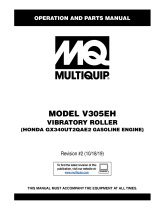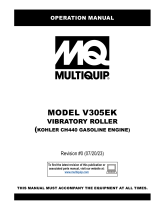
PAGE 12 — AR13HA/AR13HAR ROLLER (S/N 110301 & UP) • OPERATION AND PARTS MANUAL — REV. #0 (06/22/11)
GENERAL INFORMATION
The AR13HA/HAR roller has been designed for asphalt
application and compaction of granular soils used in
site preparation. Use the machine only for the purpose
intended and by experienced personnel who understand
this operation manual and all safety decals. Typical
applications for this roller are driveways, patch work and
road repairs. Standard features included with this roller
are articulated steering, double drum hydrostatic drive,
front drum vibration, high curb clearance and on-board
water capability.
POWER PLANT
The AR13HA/HAR roller is powered by a Honda GX630,
air-cooled, gasoline engine rated at 20 hp @3,500 rpm.
The engine features a side-mounted muffler designed to
direct engine exhaust away from the operator. In the event
of low oil, this engine has a built in "oil alert system" that
will shut down if the engine oil level reaches an unsafe
operating level.
HYDRAULIC SYSTEM
The Honda GX630 engine drives an axial hydraulics,
variable displacement pump which is manually controlled
via a cable control system. Pump flow is directed through
an aluminum block manifold which provides the control for
the 3 hydraulic motors.
The hydraulic drum drive system incorporates a parallel
closed loop configuration operating at a maximum pressure
of 2,900 psi. In addition this hydraulic system offers a "free
wheel valve" which allows the roller to be towed in the event
of an emergency.
COMPACTION SYSTEM
The compaction force is delivered by a 36-inch wide steel
drum with beveled edges to help prevent asphalt marring.
A fully enclosed hydrostatic drive system offers a variable
speed control as well as smooth acceleration and braking.
Connected to the axial hydraulic pump is a gear pump
that provides power for the drum vibratory system and
the articulating steering system. Oil from this pump flows
to the manifold control valve block and then to a hydraulic
motor which rotates the eccentric weights inside a sealed
housing containing oil to lubricate the bearings.
A pushbutton switch located on top of the gearshift lever,
when pressed, activates a hydraforce valve that engages
or disengages the vibratory action. The drum's vibratory
action generates 3,100 lbs. (1,406 Kg.) of centrifugal force
at a frequency of 4,000 vpm (vibrations per minute). If the
vibration appears to be weak or slow, allow the machine to
warm-up thoroughly, and check the hydraulic oil level. Add
hydraulic oil if necessary.
The vibrator housing and drum are shock mounted to
isolate the engine compartment and operator from vibration.
The roller nominally has an operating weight of 3,088 lbs
(1,400 Kg.), but can be increased to 3,309 lbs (1,500 Kg.)
by adding a water ballast to the rear drum.
HYDRAULIC OIL FILTER SYSTEM
The hydraulic system oil is filtered by a screen type filter
located in the reservoir filler neck, then doubled filtered
within the system first by a 40 micron mesh-type suction
filter located in the tank and the by a Zinga 10-micron,
cartridge style, spin-on return line filter.
ARTICULATED STEERING SYSTEM
Power for the articulated steering system, which uses a
single hydraulic cylinder, is provided by the gear pump.
This steering system can produce an inside turning radius
of 109 inches (2.77 meters).
SPRINKLER SYSTEM
A 40-gallon (181 liters) water tank with a gravity feed spray
bar is provided for wetting the roll for asphaltic pavement
rolling.
The water system is fully adjustable from the operator’s
position by adjusting the two water valves. The front valve
controls the water supply to the front drum, and the rear
valve controls water to the rear drum.
Before starting an asphalt rolling job, be sure all spray bar
holes are clear of dirt or foreign matter and are working.
Always use clean fresh water in the water tank. To prevent
rust and foreign debris from clogging the spray bar holes,
drain and flush water tank and spray bars every 30 days.
LIFTING THE ROLLER
When lifting of the roller is required, attach a
suitable hook or shackle to the lifting eye of the
roller. These four lifting points are marked by a
lifting hook decal. Make sure the lifting device
is capable of lifting 4,000 lbs. (1,814 Kg).



































